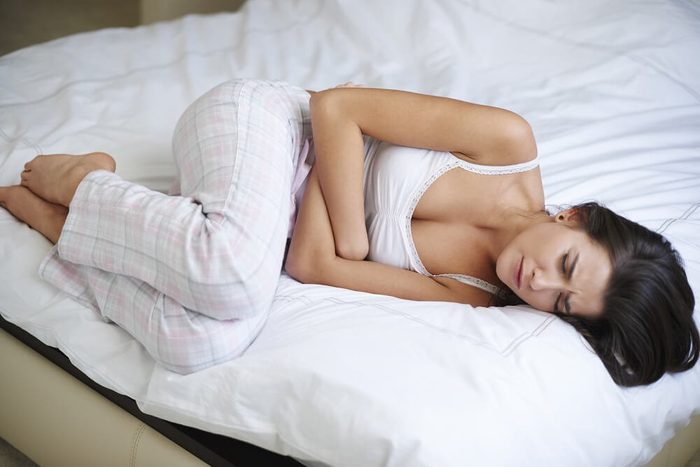
Identify the type of left side abdominal pain
“Abdominal pain is a common symptom that leads to millions of outpatient visits, and is, in fact, one of the most common reasons for people to see a doctor,” says Rosario Ligresti, MD, Chief, Division of Gastroenterology at Hackensack University Medical Center. If the left side abdominal pain came on suddenly and is so severe that the patient goes to the emergency room, says Dr. Ligresti, then a doctor may run specialized diagnostic x-ray tests, including a CT scan. While serious conditions such as ruptured aortic aneurysm, an aortic tear, perforated or twisted bowel, and low blood flow conditions to the bowel (ischemia) may require emergency surgery to correct, many other conditions can be safely evaluated in the doctor’s office.
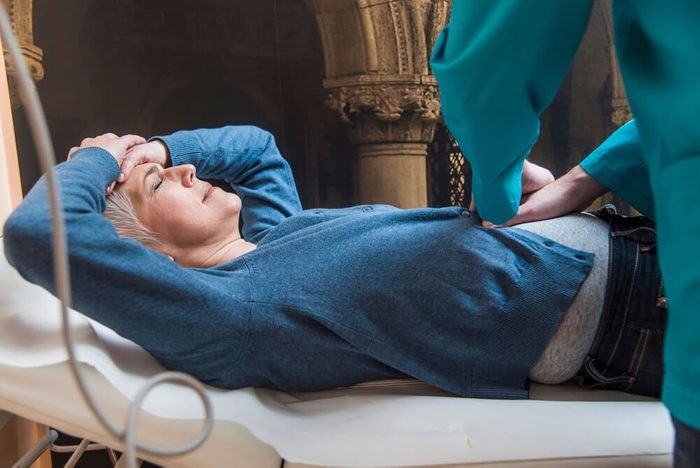
Locate the pain
When determining the cause of left side abdominal pain, the doctor will first find the exact location, explains Dr. Ligresti. If the pain is mostly in the upper left of the abdomen, it could be stomach or kidney causes like indigestion, gas, reflux, gastritis, ulcers, and kidney stones, he says. If it is in the left lower abdomen, doctors tend to think of colon conditions (diverticulitis and colitis), gynecologic causes (ovarian cysts or endometriosis), or testicular conditions. In addition to pain, a doctor will look for fever, bloody stools, persistent nausea and vomiting, weight loss, or change in urination. “We also want to know if the pain is associated with numbness, burning, tingling or itching of the skin, or if there are any skin rashes (especially blisters) over the area,” says Dr. Ligresti.
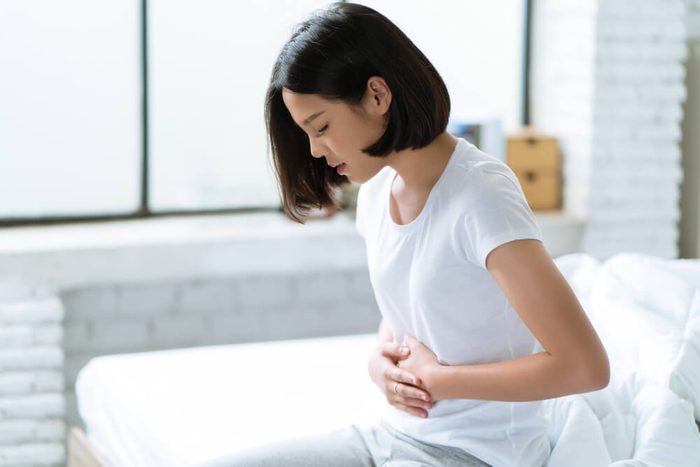
Diverticulitis
HealthLinkBC defines diverticulitis as inflammation of the pockets (diverticula) in the wall of the colon. “Diverticulitis is one of the most common sources of left lower abdomen pain and classically presents with associated fever, change in bowel habits, sometimes bloody stools, chills, and fairly localized symptoms,” says Dr. Ligresti. In serious cases, diverticulitis can lead to bleeding, tears, or blockages. Diagnosing the condition requires a physical exam and imaging tests. “This is an important diagnosis to make since it requires treatment with antibiotics right away,” says Dr. Ligresti. Diagnosed with diverticulitis? Here’s how to live better with this disease.
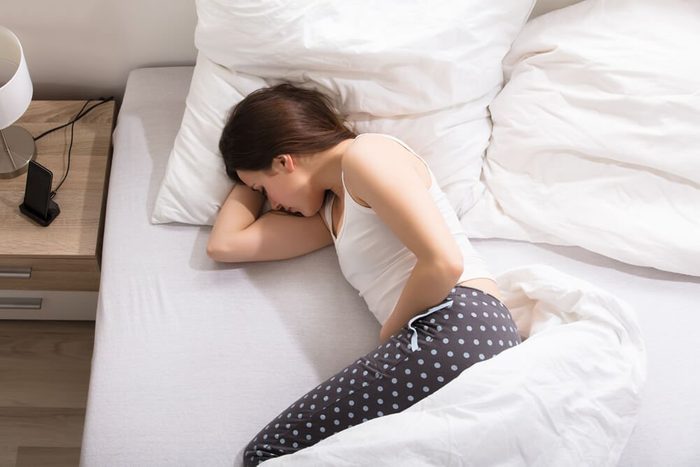
Colitis
While the abdominal pain associated with diverticulitis often occurs suddenly, the symptom of colitis (inflammation of the colon) appear more gradually. “Also, colitis tends to present with changes in bowel function (diarrhea or bloody diarrhea) and diverticulitis usually does not,” says Dr. Ligresti. Colitis is often caused by infections (such as from food poisoning), poor blood supply, and autoimmune reactions. There are also different types of the condition, including Crohn’s disease and ulcerative colitis, a type of inflammatory bowel disease.

Gastritis
This term is a catchall for conditions that involve inflammation of the lining of the stomach. The inflammation can be due to an infection, regular use of pain relievers, or drinking too much alcohol. Symptoms of gastritis may happen suddenly (acute gastritis) or occur slowly (chronic gastritis), and in some cases, gastritis can lead to ulcers. Ulcers and gastritis are some of the most common causes of left upper abdominal pain and typically present with a deep, gnawing left side abdominal pain that may get worse at night and then improve after eating, explains Dr. Ligresti. These conditions can also often be associated with nausea and vomiting, weight loss, and dark stools. “This is an important diagnosis to make since treatment is very effective if started early,” he says. Here are 9 weird pooping habits, explained by science.
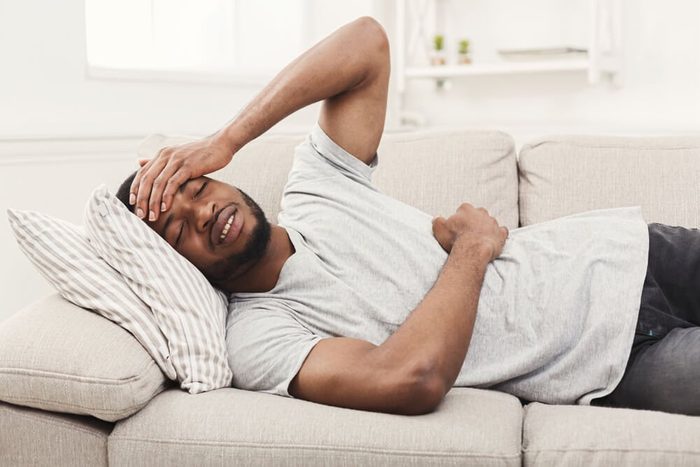
Shingles
If you’ve had chickenpox, the virus—varicella-zoster—can lie dormant for decades before returning as shingles. People often mistake the symptoms for another illness, according to the National Shingles Foundation. If your left side abdominal pain comes with skin symptoms like a rash, numbness, or burning, your doctor will need to test for shingles, says Dr. Ligresti.
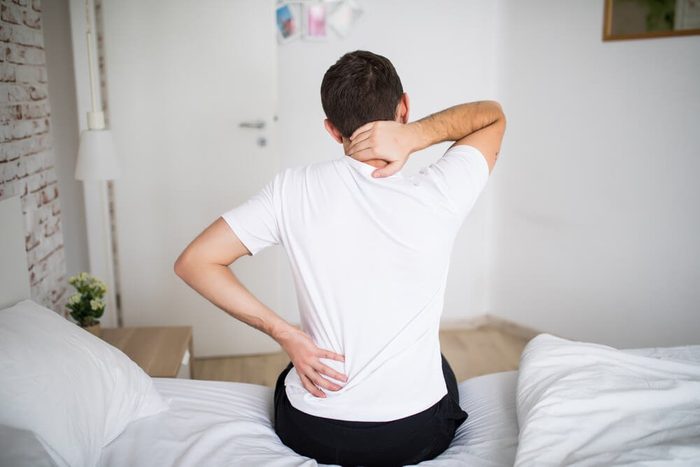
Abdominal aortic aneurysm
This is a scary one because the aorta is a major blood vessel that supplies blood to the body, explains Gina Lynem, MD, physician consultant at Blue Cross, Blue Shield of Michigan. An abdominal aortic aneurysm (AAA) means a wall of the aorta is bulging, and it often grows slowly without symptoms; a burst AAA is life-threatening. “As an abdominal aortic aneurysm enlarges, some people may notice a pulsating feeling near the navel, deep constant pain in the abdomen or on the side of your abdomen, or back pain,” she says. Every year, 200,000 people in the U.S. are diagnosed with an abdominal aortic aneurysm, according to the Society for Vascular Surgery. “If you have any of these symptoms, you should see your physician immediately,” says Dr. Lynem.
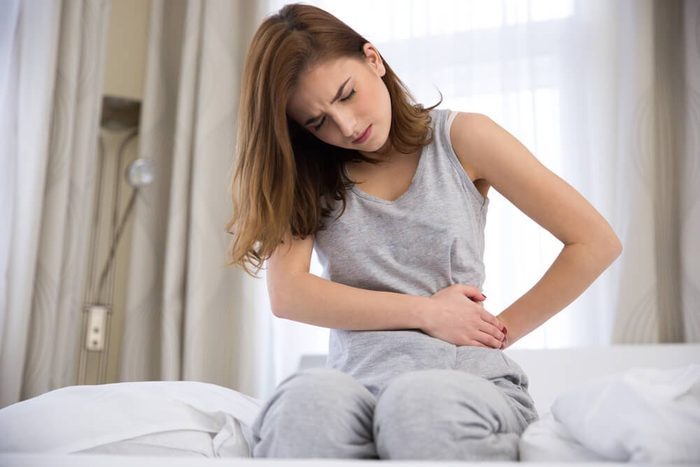
Indigestion
We all know the feeling of discomfort, feeling too full after eating, bloating, a burning sensation in your gut, and belching. Also known as dyspepsia, indigestion can result from underlying issues with diet, anxiety, reaction to medications, pregnancy, or disease, explains Dr. Lynem. There are a variety of over-the-counter medicines available to treat indigestion, but often evaluating and changing your diet is the most effective course, she says. Bloated? Here’s how to tell if it’s IBS.
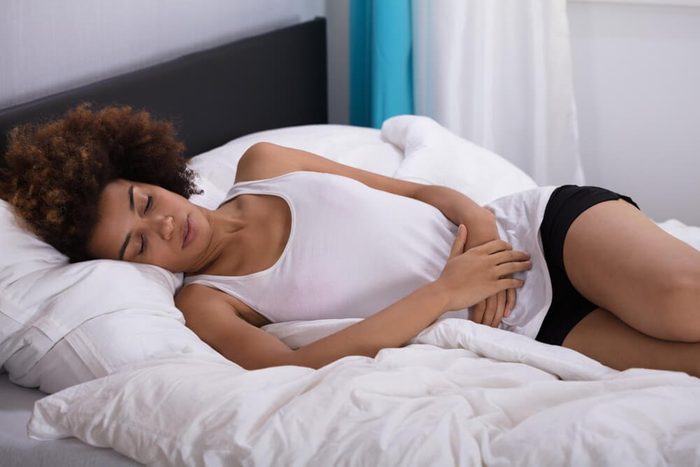
Ovarian cysts
The ovaries are located in the lower abdomen on both sides of the uterus. Some women experience ovarian cysts, fluid-filled sacs that develop on the ovaries, but usually they’re painless and go away on their own. “Many women won’t even realize they’ve had one,” says Dr. Lynem. “However, in some cases, they can trigger pelvic pain.” If the left side abdominal pain is sharp, accompanied by fever, dizziness, or rapid breathing, it may indicate a ruptured cyst or ovarian torsion; both need immediate treatment. While there is no way to prevent an ovarian cyst, they can be detected during a routine pelvic examination or through ultrasound. Here’s what to know if you’ve been diagnosed with ovarian cysts.
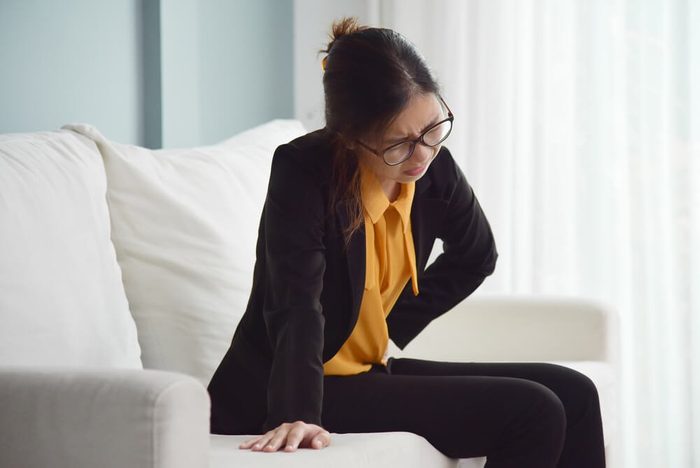
Kidney stones
Kidney stones occur when pieces of the hard mineral deposits that build up naturally in the kidney break off and enter your ureter, explains Dr. Lynem. “In addition to abdominal pain, you’ll likely notice urinary symptoms such as discomfort, discoloration, a foul smell, or persistent need to empty the bladder,” she says. According to the National Kidney Foundation, more than a half-million people go to emergency rooms for kidney stone problems every year. Kidney stones are caused by not drinking enough water, exercise (too much or too little), obesity, weight-loss surgery, or eating food with too much salt or sugar. “The best way to prevent and get through the pain of a kidney stone is to stay well-hydrated,” says Dr. Lynem. Here’s how long it takes to pass a kidney stone.
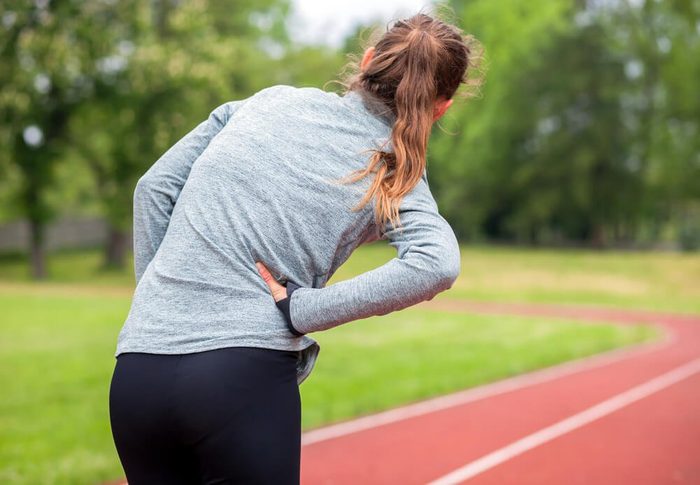
Pulled or strained abdominal muscle
Lifting, twisting, doing too many sit-ups or crunches, and even hard coughing or sneezing can strain an abdominal muscle: “A pulled abdominal muscle or abdominal strain most commonly results from overstretching or over-exercising,” says Dr. Lynem. “It will feel like a cramp that could also involve acute pain, bruising, swelling, or spasms.” The best way to recover is to rest and apply a cold pack for comfort, she says. Here are 5 reasons your stomach hurts.

Pelvic inflammatory disease
PID is an infection and inflammation of a woman’s pelvic organs, including the uterus, fallopian tubes, ovaries, and cervix. You can treat it with antibiotics, explains Dr. Lynem. Sexually active women under the age of 25 are at highest risk for developing PID. According to the Centers for Disease Control, PID is often caused by untreated sexually transmitted diseases (STDs), and one out of eight women with PID will experience difficulty getting pregnant. “Pelvic inflammatory disease may not produce any symptoms, but in other cases, it can cause abdominal or pelvic pain, fever, vaginal discharge, painful urination, or painful sexual intercourse,” says Dr. Lynem.
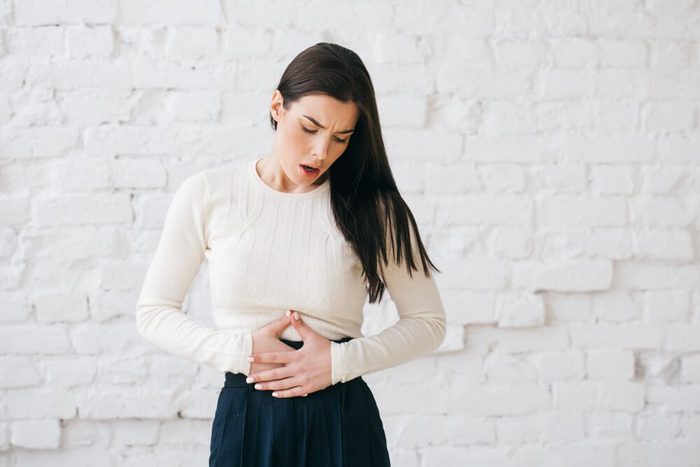
Gas
Burping, flatulence, bloating, and pain or discomfort in your abdomen are all symptoms of gas—a normal part of the digestive process. Most people pass gas 13 to 21 times per day. “Gas is typically not painful, but it can be annoying and embarrassing,” says Dr. Lynem. Gas is most often caused by swallowing air (from chewing gum or eating or drinking too fast) or when bacteria in the large intestine break down certain foods that are prone to cause gas. “Diet is often to blame for an increase in gas,” says Dr. Lynem. People with certain conditions such as celiac disease, irritable bowel syndrome, or an intolerance to lactose or fructose are also more likely to experience gas.

Hernia
The most obvious symptom of a hernia is a bulge or lump in your abdomen that results from an organ pushing through an opening in muscle or other tissues, explains Dr. Lynem. According to the Cleveland Clinic, there are several types of hernia, but the most common (representing 75 to 85 percent of the cases) are inguinal: The intestine or the bladder pops through the abdominal wall or the groin. You may be able to push the lump or bulge back in, or it may disappear when you lie down, but activities such as crying, laughing, coughing, or physical activity can push the lump back out—and it can be painful. Other symptoms of a hernia include a dull aching sensation, feeling full, and pain when lifting objects. “A doctor should be consulted for a specific treatment plan that may or may not require surgery,” says Dr. Lynem.

Intestinal obstruction
This is a partial or complete physical blockage of your small or large intestine that prevents routine digestion, explains Dr. Lynem. Common causes include scar tissue resulting from surgery, hernia, and tumors; symptoms can include pain, bloating, and loss of appetite. “Treatment varies, depending on the source and severity of the blockage, but a blockage can be severe enough to require a hospital stay and even surgery, so be sure to seek immediate treatment if you are not passing any gas or stool,” says Dr. Lynem. If you don’t get treatment, your intestine can rupture—and that can be deadly. Next, check out these medical reasons for your lower abdominal pain.
